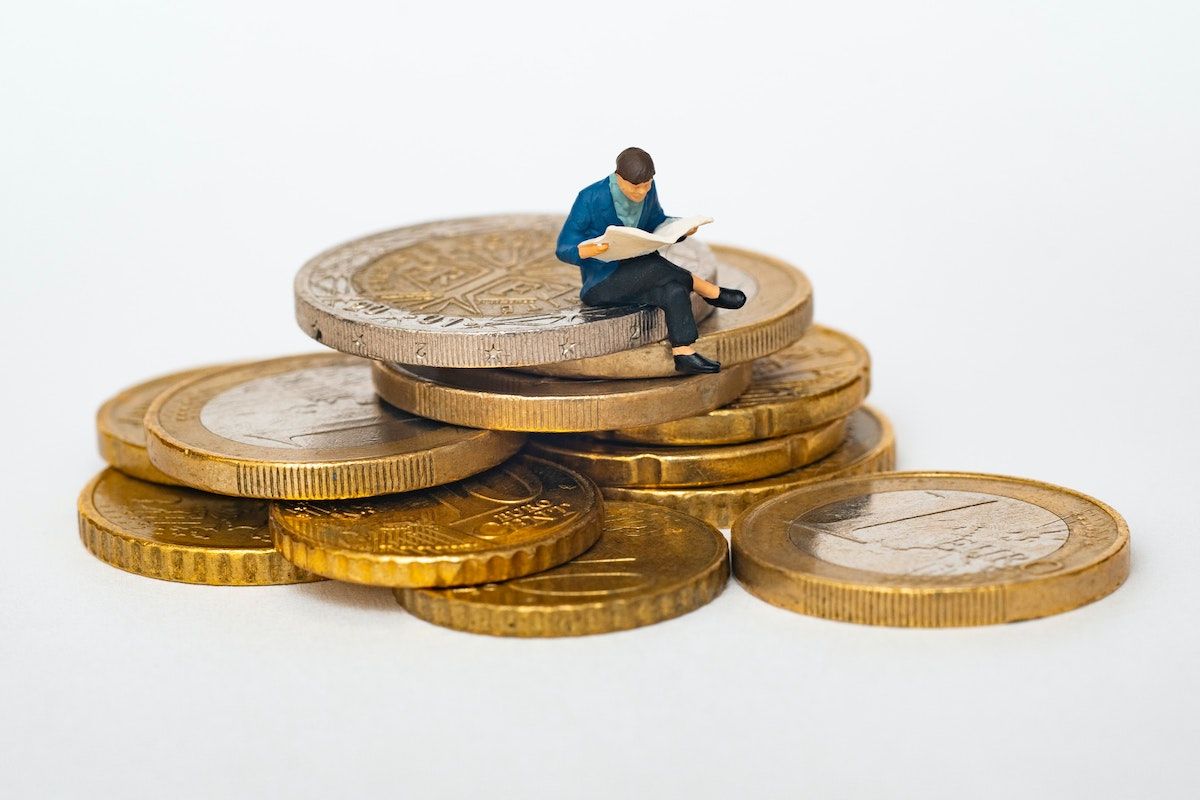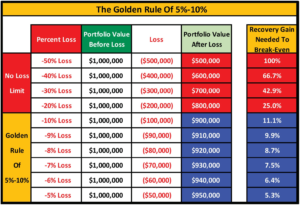
The Golden Rule of 5% to 10%
Protecting Yourself Against Big Portfolio Losses
Because of how painful portfolio losses can be to retirees, we created The Golden Rule Of 5% To 10%. The Golden Rule Of 5% To 10% states you should not have your assets positioned to lose more than -5% to a maximum -10% of your total portfolio, even if the stock market crashes and loses -50% or more.
If you are like many retirees, right now you may be very nervous, anxious, and worried about your money simply because you are afraid of suffering through the next big stock market crash. You are not sure how much you could lose, but you know at this time in your life, a big loss could be devastating. If your money is currently unprotected in the stock market, you should be nervous because none of us like uncertainty. Following The Golden Rule Of 5% To 10% may help decrease your worries.
As we begin our discussion, we’ll use the chart below to give you a visual.
Understanding the Golden Rule of 5% – 10%
The first section of the chart is called “No Loss Limit” which shows the tremendously negative impact of large stock market losses on your portfolio including -50% losses, -40% losses, -30% losses, and -20% losses coupled with the “Recovery Gain Needed To Break Even.”

What we are discussing right now is called the “recovery factor,” simply meaning how much do you need to earn after a loss just to break even. We created this “recovery factor” concept to help retirees be aware of the true total risk they are taking. Think about it, is the true risk the -50% you could lose or is it the +100% you must earn to get back to even? The answer: true risk is the combination of the initial loss followed by the recovery gain required to make up that loss.
It’s very important to remember that there are actually two components to risk: the loss itself and the recovery gain needed before you just break even. From the chart above consider the -50% loss – step one – of the risk and consider the +100% recovery gain – step two.
SEE ALSO: Average Retirement Debt for Older Americans is Higher than Ever Before
Don’t Be Caught ‘Naked in the Market’
We call the “No Loss Limit” being “Naked in the Market,” meaning you have no protection against the elements. The “No Loss Limit” section shows the following:
If you suffer a -50% portfolio loss, your $1,000,000 portfolio would lose -$500,000, dropping your portfolio value to $500,000 after the loss. You need a +100% recovery gain on your $500,000 decreased portfolio value just to get back to even at $1,000,000. How long would it take you to make a 100% gain just to get back up to even, not get ahead, just to recover? Do you have that amount of time to wait during retirement for it to recover before you use it for income? Probably not, because you’re in retirement and you’re not adding to those savings any longer. Are you guaranteed it will recover for sure? Are you guaranteed it will recover in a certain amount of time? Are you guaranteed it will recover if you are taking income distributions? You are not guaranteed any of these things.
This -50% type of stock market loss happened from 2000 through 2002 and then again from October 2007 through March 2009. If you owned the S&P Index and you lost -50% from 2000 through 2002, you needed to make +100% just to get back to even by 2007. Then you lost -50% again from October 2007 through March 2009, then had to make +100% from April 2009 through January 2013 just to break even again. And this doesn’t account for the fees you paid and lost over that entire 13-year time period.
What if you suffer a -50% portfolio loss and you are taking income distributions out of the account? You have a big problem that may prove to be catastrophic to your long-term financial security as your money might run out.
If you suffer a -40% portfolio loss, your $1,000,000 portfolio would lose -$400,000, dropping your portfolio value to $600,000 after the loss. You need a +66.7% recovery gain on your $600,000 decreased portfolio value just to get back to even at $1,000,000. You need to understand what this is really saying. In this example, you have first lost -40%, and then you made 66.7% just to fight to get back to even. You haven’t made any gain at all.
What if you lose 30% and your $1,000,000 dollars goes down to $700,000 during retirement? How would that feel? How much does $700,000 have to earn to get back up to even? You have to earn a 42.9% rate of return on the $700,000 just to get back up to even, not to make any money, just to get back to even.
If you suffer a -20% portfolio loss, your $1,000,000 portfolio would lose -$200,000, dropping your portfolio value to $800,000 after the loss. You need a +25% recovery gain on your $500,000 decreased portfolio value just to get back to even at $1,000,000. How easy is it to make +25%, +42.9%, +66.7%, or +100% gains? Not very easy. Are you guaranteed to make these types of large gains immediately after a loss? Are you guaranteed you will make these types of large gains up over a certain time period after a loss? All these types of gains required for recovery are huge, and it could take a long time before you fully recover. That’s why we’ve created The Golden Rule Of 5% To 10%.
SEE ALSO: Warning Signs About Your Money
Let’s Do the Math
The second section of the chart, directly below the “No Loss Limit” section highlighted in red is, “The Golden Rule Of 5% To 10%” – which is highlighted in gold. The concept is simple but may be the most important thing for you to adhere to throughout your retirement: Do not be in a position to lose more than -5% up to a maximum of -10% of your portfolio. Why? Because -5% to -10% losses are easier to make up than -20% to -50% losses. Why? Because of the math!
If you suffer a 10% loss of your $1,000,000, your portfolio would drop to $900,000, and you would need to earn a +11.1% recovery gain to break even. The mathematical fact is that +11.1% is easier to make up than +25%, +42.9%, +66.7%, and +100%. Making up +11.1% is doable over a shorter time period.
What if you have a -9% loss and your portfolio drops to $910,000? A 9% loss requires a +9.9% recovery gain.
What if you have an 8% loss and your portfolio drops to $920,000? You need an 8.7% recovery.
A 7% loss dropping your portfolio to $930,000 requires a 7.5% recovery gain.
A 6% loss dropping your portfolio to $940,000 requires a 6.4% recovery gain.
And a 5% loss, meaning your $1,000,000 million goes down to $950,000 would only require a 5.3% recovery gain to get back up to even.
If you limit your losses to between -5% to -10%, that means your required recovery gains only are between +5.3% up to a maximum of +11.1%.
The mathematical fact is that it is easier to make recovery gains between +5.3% to +11.1% than it is to make recovery gains of between +25% to +100%.
The Psychological Impact of Losses During Retirement
Let’s dive deep into what happens psychologically when you suffer a big loss during retirement. If you lose -20%, -30%, -40%, or -50%, you may be scared and won’t want to invest aggressively and risk your money any longer. But to recover from a big loss, and if you need to make up gains of +25%, +42.9%, +66.7%, or +100%, how must you invest your money? Can you invest your money conservatively and hope to get these returns? The only chance, the only possibility you will have to potentially recover from a large loss is to invest aggressively. And think about it, this will be exactly the opposite of what you will want to do. But if you limit your portfolio losses to between 5% to 10%, the recovery gains needed are significantly lower and you won’t have to invest as aggressively after the loss to try and recover.
We have found that most retirees we work with are comfortable with a risk tolerance between -5% to -10%, which fits perfectly with The Golden Rule Of 5% To 10%.
Want more content like this? Check out our book, Momma’s Secret Recipe for Retirement Success. Download the cliff notes here, or get your full copy on Amazon.